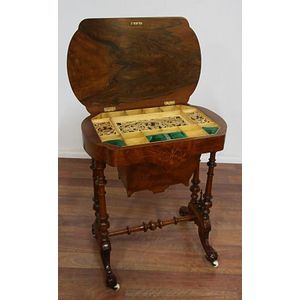Victorian Walnut Work Table with Fitted Interior
Victorian figured walnut work table hinged top, fitted interior, frieze drawer with pull out drawer beneath, on scroll legs joined by turned stretcher
You must be a subscriber, and be logged in to view price and dealer details.
Subscribe Now to view actual auction price for this item
When you subscribe, you have the option of setting the currency in which to display prices to $Au, $US, $NZ or Stg.
This item has been sold, and the description, image and price are for reference purposes only.
- Turning - Any part of a piece of furniture that has been turned and shaped with chisels on a lathe. Turned sections include legs, columns, feet, finials, pedestals, stretchers, spindles etc. There have been many varieties and fashions over the centuries: baluster, melon, barley-sugar, bobbin, cotton-reel, rope-twist, and so on. Split turning implies a turned section that has been cut in half lengthwise and applied to a cabinet front as a false decorative support.
- Scroll Legs - are in the form of an elongated scroll or 's' shape, from which the cabriole leg also derived. Scroll legs, however, are usually rather more substantial and are frequently found supporting side tables and hall tables throughout much of the 19th century. As a rule, the back legs of such tables intended to remain against the wall were flat and rectangular.
- Frieze - An architectural term denoting the flat, shaped or convex horizontal surface of furniture, between the architrave and the cornice, usually found on a cabinet or bookcase, or on desks and tables where it may include drawers, the area between the top and the legs. In ceramics, the term refers to the banding, of usually a repeating pattern, on the rims of plates and vases.
- Victorian Period - The Victorian period of furniture and decorative arts design covers the reign of Queen Victoria from 1837 to 1901. There was not one dominant style of furniture in the Victorian period. Designers used and modified many historical styles such as Gothic, Tudor, Elizabethan, English Rococo, Neoclassical and others, although use of some styles, such as English Rococo and Gothic tended to dominate the furniture manufacture of the period.
The Victorian period was preceded by the Regency and William IV periods, and followed by the Edwardian period, named for Edward VII (1841 ? 1910) who was King of the United Kingdom and the British Dominions and Emperor of India for the brief period from 1901 until his death in 1910. - Figured - A descriptive term to describe the patterns in the grain of timber. An object may be described as "well figured" or "highly figured" if the grain on a section of the object is highly patterned, as with flame mahogany or burr walnut.
- Stretcher - A horizontal rail which connects the legs of stools, chairs, tables and stands, to provide stabilisation of the legs. A stretcher table is any table with a stretcher base. The term is usually applied to substantial farmhouse tables, although many cabinetmaker's pieces, such as sofa tables, also have turned stretchers.
This item has been included into following indexes:
Visually similar items

A Victorian burr walnut marquetry inlaid sewing table. 73 cm high, 63 cm wide, 41 cm deep.
Sold by
in
for
You can display prices in $Au, $US, $NZ or Stg.

Fine antique English inlaid walnut work/games table, approx 75 cm high, 61.5 cm wide, 41 cm depth
Sold by
in
for
You can display prices in $Au, $US, $NZ or Stg.

A small 19th century oak Sutherland table
Sold by
in
for
You can display prices in $Au, $US, $NZ or Stg.

An oak drop leaf table with turned legs, English 17th/18th century, 70 cm high, 120 cm wide, 47 cm deep and 120 cm diameter extended
Sold by
in
for
You can display prices in $Au, $US, $NZ or Stg.
